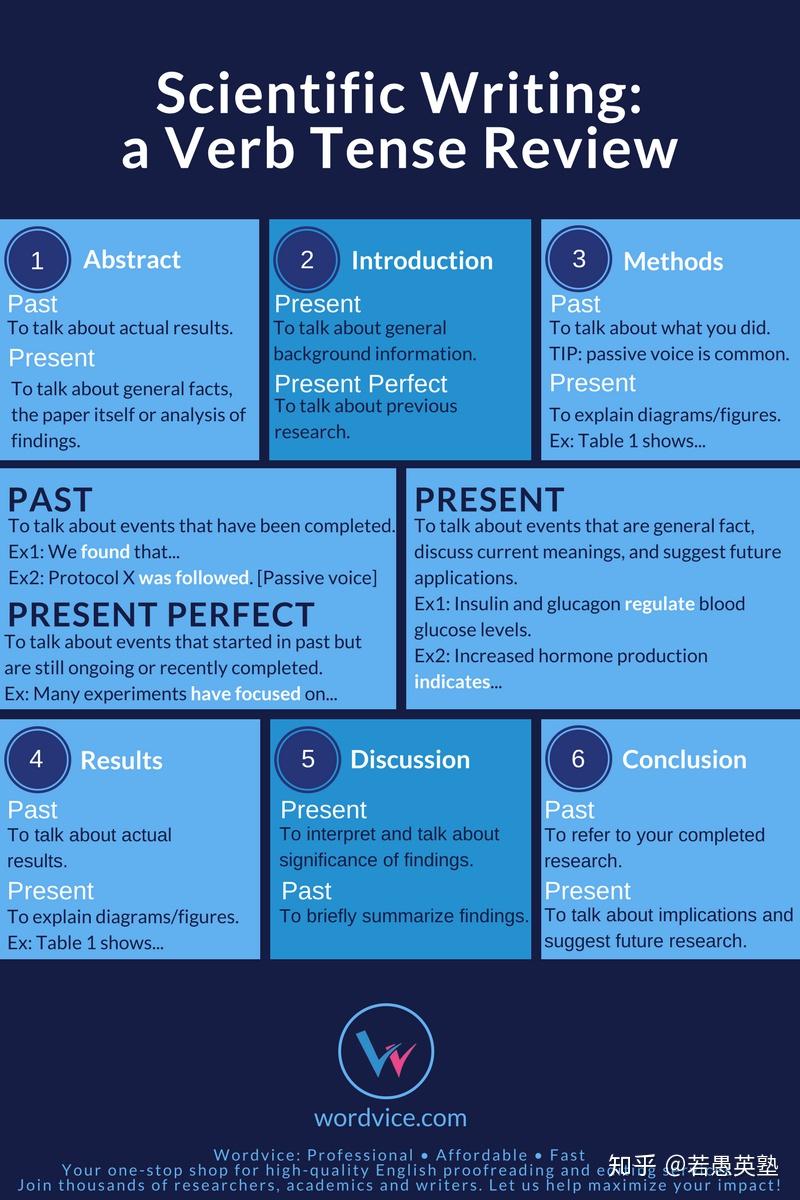

医学英语写作大讲堂开讲啦!
经常有人弄不清楚在写SCI论文过程中,时态具体该怎样用,这篇文章就具体分析了时态的用法,希望对大家有所帮助。
相比于传说中的英文16种时态,SCI其实用到的最主要就是其中的2种(一般现在时和一般过去时),已经算是很大程度的简化了,把各种情况梳理一遍,写作时应该就不会觉得混乱了。
首先,咱们来复习一下这两种时态所适用的情况,不管写什么文章,时态的运用肯定都符合英语语法的基本原理。
一般现在时:
主要用于描述不受时间限制的客观存在事实或真理,简单地说,写作当时你觉得是正确的或正在发生的内容,都可以用一般现在时。比如,客观陈述他人已经发表的研究成果作为佐证时,普遍都用一般现在时。 基于此,“Introduction”中的文献回顾和 “Discussion”中的大部分,都可用一般现在时描述。
一般过去时:
用于描述发生于论文写作之前的事情,包括作者自己所做的工作。比如,论文中“Materialand Methods” 和 “Results” 的大部分,这些在论文动笔前肯定都已经做完,整理完了,所以用过去时,不难理解。
p.s. 一般现在时和一般过去时是写作中最常用到的两个时态,但在实际写作中,当然还会运用到其它一些时态,比如将来时,现在完成时,甚至过去时,以适应丰富的文章内容,下面会给大家详细讲解。
接下来,咱们结合SCI文章内容,看看具体论文中时态应该如何使用。一般的Original Article 通常包括 Abstract, Introduction, Materials and Methods, Results, Discussion, Conclusion 这几个部分,每个部分大概有什么内容大家应该都有了解吧?其它类型的文章也都可以根据这种类型举一反三,那我就直接以Original Article为例讲时态运用了哈。
摘要(Abstract):
一般情况下,研究背景,实验目的,论文结论,采用一般现在时。实验方法,结果及发现,采用过去时。举几个栗子:
研究背景:A method to select non-responders as early as possible is essential for preventing unnecessary toxicity.
实验方法:Human breast cancer cells were injected into nude rats.
实验结果:A new in vivo breast cancer model was successfully established.
论文结论:The present study suggests that ...
当然,有些杂志也会专门有些比较“特别”的要求,比如Cell,要求Abstract全部使用一般现在时。大家可以自行体会下:
Here we present a unifying hypothesis about how messenger RNAs, transcribed pseudogenes, and long non-coding RNAs “talk” to each other using microRNA response elements (MREs) as letters of a new language. We propose that this “competing endogenous RNA” (ceRNA) activity forms a large-scale regulatory network across the tranome, greatly expanding the functional genetic information in the human genome and playing important roles in pathological conditions, such as cancer.
前言(Introduction):
这部分用到的时态很多变,不能一概而论。
研究背景描述的如果是经典原理,事实,或目前为止最前沿的结果,作者写论文时仍认为是正确的(即使是曾经发生的),用一般现在时。
比如:CircRNAs are recently identified as a naturally occurring family of noncoding RNAs that is highly represented in the eukaryotic tranome.
描述已经完成的事,强调 “曾经”,目前为止对此持肯定态度,用现在完成时。
比如:A large number of circRNAs have been successfully identified in various cell lines and across different species.
曾经的研究,其结果现在为止仍然正确,则一句话中可以既有完成时,也有一般现在时。
比如:Recent studies have shown that exon circularization is facilitated by complementary sequences and regulated by specific protein factors.
以作者为主语,阐述曾经的研究结果,如果该研究结果仍然正确,则谓语动词用过去时,从句中仍使用一般现在时。
比如:Poliseno et al. recently proposed that the high sequence homology enablespseudogenes to compete with their parental genes for a shared pool of common miRNAs.
曾经的研究,但已经过时或失效,作者怀疑其正确性,或要否定其正确性时,用过去时或过去完成时。
比如:Nevertheless, these species had generally been considered to be of low abundance and likely representing errors in splicing.
LincRNA-p21 was initially identified as a direct tranional target of p53.
材料与方法(Materials and methods):
描述写论文之前作者所做的工作,用一般过去时。
比如:The proliferation of Huh-7, HCT-116, HeLa cells was tested by CCK-8 kit.
这部分一般时态变化比较少,没什么争议。
结果(Results):
描述自己的研究结果,因其发生于写作之前,用过去时。
比如:In total, 67,358 distinct circRNA candidates were found in these tissues and 27,296 of these circRNAs contained at least two unique back-spliced reads.
但是,单纯描述结果呈现形式(图或表),或直接用图或表作为主语时,因为是写作当时发生的事,所以使用一般现在时。
比如:A detailed summary for each sample is provided in Supplementary Table 1.
Figure 1 shows the mean spectra for the original data.
讨论:
对此次研究结果的总结,用过去时。
比如:In this study, we identified lincRNA-p21 as a key regulatorof cell proliferation and apoptosis.
对Results部分的结果描述进行更深入的分析和讨论,阐述结果的意义,用一般现在时。
比如:However, certain circRNAs are predominately expressed in one gene locus and present at substantial levels that suggest these species are purposefully produced.
结论:
强调过去的研究成果采用过去时,表达将来的研究方向或研究前景用将来时。
比如,In conclusion, our study provided a portrayal of circRNAs in different human normal and cancerous tissues.
阐述自己研究成果的意义用一般现在时。
比如,Taken together, these lines of evidence reveal a new level of diversity in the tranome and their regulation in human cells.
提出研究前景或将来的研究方向用将来时,这部分也可能出现在Discussion中。
比如,It willbe interesting to explore whether lincRNA-p21 can interact with epigenetic factors
 参考文献
参考文献
Thomson, D.W. and M.E. Dinger, Endogenous microRNA sponges: evidence and controversy. Nat Rev Genet, 2016. 17(5): p. 272-83.2.
Wu, G., et al., LincRNA-p21 regulates neointima formation, vascular smooth muscle cell proliferation, apoptosis, and atherosclerosis by enhancing p53 activity. Circulation, 2014. 130(17): p. 1452-65.3.
Karreth, F.A., et al., The BRAF pseudogene functions as a competitive endogenous RNA and induces lymphoma in vivo. Cell, 2015. 161(2): p. 319-32.4.
Zheng, Q., et al., Circular RNA profiling reveals an abundant circHIPK3 that regulates cell growth by sponging multiple miRNAs. Nat Commun, 2016. 7: p. 11215.
Salmena, L., et al., A ceRNA hypothesis: the Rosetta Stone of a hidden RNA language? Cell, 2011. 146(3): p. 353-8.
本文转自https://zhuanlan.zhihu.com/p/143586597